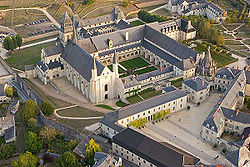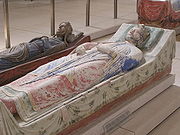
Fontevraud Abbey
Encyclopedia


Fontevraud-l'Abbaye
Fontevraud-l'Abbaye is a commune in the Maine-et-Loire department in western France. It is situated both in the Loire Valley, an UNESCO World Heritage Site between Chalonnes-sur-Loire and Sully-sur-Loire, and the Loire Anjou Touraine French regional natural park.-External links:****...
, near Chinon
Chinon
Chinon is a commune in the Indre-et-Loire department in central France well known for Château de Chinon.In the Middle Ages, Chinon developed especially during the reign of Henry II . The castle was rebuilt and extended, becoming one of his favorite residences...
, in Anjou
Anjou
Anjou is a former county , duchy and province centred on the city of Angers in the lower Loire Valley of western France. It corresponds largely to the present-day département of Maine-et-Loire...
, France. It was founded by the itinerant reforming preacher Robert of Arbrissel
Robert of Arbrissel
Robert of Arbrissel was an itinerant preacher, and founder of the abbey of Fontevrault. He was born at Arbrissel near Rhétiers, Brittany; and died at Orsan.-Biography:...
, who had just created a new order, the Order of Fontevrault. The first permanent structures were built between 1110 and 1119.
It is situated in the Loire Valley
Loire Valley
The Loire Valley , spanning , is located in the middle stretch of the Loire River in central France. Its area comprises approximately . It is referred to as the Cradle of the French Language, and the Garden of France due to the abundance of vineyards, fruit orchards, and artichoke, asparagus, and...
, an UNESCO World Heritage Site
World Heritage Site
A UNESCO World Heritage Site is a place that is listed by the UNESCO as of special cultural or physical significance...
between Chalonnes-sur-Loire and Sully-sur-Loire, and is within the Loire-Anjou-Touraine French regional natural park (Parc naturel régional Loire-Anjou-Touraine).
History
Philippa of ToulousePhilippa of Toulouse
Philippa Maude of Toulouse , also known as Philippa de Toulouse or Philippa de Rouergue, was the Duchess Consort of Aquitaine, and Countess of Toulouse...
persuaded her husband William IX, Duke of Aquitaine to grant Robert of Abrissel land in Northern Poitou to establish a religious community dedicated to the Virgin Mary . The abbey was founded in 1100 and became a double monastery
Double monastery
A double monastery is an institution combining a separate monastery for monks and an abbey for nuns. Examples include Coldingham Monastery in Scotland, and Einsiedeln Abbey and Fahr Abbey in Switzerland, controlled by the abbot of Einsiedeln...
, with both monks and nuns on the same site. An international success, the order established several "Fontevrist" abbeys set up in England. Robert of Arbrissel
Robert of Arbrissel
Robert of Arbrissel was an itinerant preacher, and founder of the abbey of Fontevrault. He was born at Arbrissel near Rhétiers, Brittany; and died at Orsan.-Biography:...
declared that the leader of the order should always be a woman and appointed Petronille de Chemillé
Petronille de Chemillé
The Venerable Petronilla of Chemillé was a widow and the first abbess of the double monastery of Fontevrault in western France governing from 1115 to 1149.Born Petronilla of Craon, she became a follower of Robert of Arbrissel...
as the first abbess. She was succeeded by Matilda of Anjou, the aunt of Henry II of England
Henry II of England
Henry II ruled as King of England , Count of Anjou, Count of Maine, Duke of Normandy, Duke of Aquitaine, Duke of Gascony, Count of Nantes, Lord of Ireland and, at various times, controlled parts of Wales, Scotland and western France. Henry, the great-grandson of William the Conqueror, was the...
. This was the start of a position that attracted many rich and noble abbess
Abbess
An abbess is the female superior, or mother superior, of a community of nuns, often an abbey....
es over the years, including members of the French Bourbon
House of Bourbon
The House of Bourbon is a European royal house, a branch of the Capetian dynasty . Bourbon kings first ruled Navarre and France in the 16th century. By the 18th century, members of the Bourbon dynasty also held thrones in Spain, Naples, Sicily, and Parma...
royal family. It also became a refuge for battered women and penitent prostitutes, and housed a leper hospital and a home for aged religious.
In the early years the Plantagenets were great benefactors of the abbey and while Isabella d'Anjou was abbess, Henry II's widow Eleanor of Aquitaine
Eleanor of Aquitaine
Eleanor of Aquitaine was one of the wealthiest and most powerful women in Western Europe during the High Middle Ages. As well as being Duchess of Aquitaine in her own right, she was queen consort of France and of England...
became a nun there. Louise de Bourbon left her crest on many of the alterations she made during her term of office.
During the French Revolution
French Revolution
The French Revolution , sometimes distinguished as the 'Great French Revolution' , was a period of radical social and political upheaval in France and Europe. The absolute monarchy that had ruled France for centuries collapsed in three years...
, the order was dissolved. The last abbess, Madame d'Antin, died in poverty in Paris. On 17 August 1792, a Revolutionary decree ordered evacuation of all monasteries, to be completed by 1 October 1792. The abbey later became a prison from 1804 to 1963, in which year it was given to the French Ministry of Culture.
The restoration of the abbey church was finished about 2006 under the direction of the architect Lucien Magne.
Features
The abbey was originally the site of the graves of King Henry II of England, his wife Eleanor of AquitaineEleanor of Aquitaine
Eleanor of Aquitaine was one of the wealthiest and most powerful women in Western Europe during the High Middle Ages. As well as being Duchess of Aquitaine in her own right, she was queen consort of France and of England...
, their son King Richard I of England
Richard I of England
Richard I was King of England from 6 July 1189 until his death. He also ruled as Duke of Normandy, Duke of Aquitaine, Duke of Gascony, Lord of Cyprus, Count of Anjou, Count of Maine, Count of Nantes, and Overlord of Brittany at various times during the same period...
, their daughter Joan, their grandson Raymond VII of Toulouse
Raymond VII of Toulouse
Raymond VII of Saint-Gilles was Count of Toulouse, Duke of Narbonne and Marquis of Provence from 1222 until his death. He was the son of Raymond VI of Toulouse and Joan of England...
, and Isabella of Angoulême
Isabella of Angoulême
Isabella of Angoulême was queen consort of England as the second wife of King John from 1200 until John's death in 1216. They had five children by the king including his heir, later Henry III...
, wife of Henry and Eleanor's son King John.
However, there is no remaining corporal presence of Henry, Eleanor, Richard or the others on the site. Their remains were possibly destroyed during the French Revolution. It is generally believed that the location of their remains within the abbey is known, but the French government will not grant permission to excavate, because finding that the remains are not where they are thought to be may result in a decrease of tourism.
Henriette Louise de Bourbon
Henriette Louise de Bourbon
Henriette Louise de Bourbon was a French Princess by birth and a member of the House of Bourbon...
, granddaughter of Louis XIV and Madame de Montespan grew up here. Princess Thérèse of France
Princess Thérèse of France
Thérèse de France, fille de France was a French Princesse du Sang.-Biography:...
, daughter of Louis XV is buried there also.
Miscellaneous
Jean GenetJean Genet
Jean Genet was a prominent and controversial French novelist, playwright, poet, essayist, and political activist. Early in his life he was a vagabond and petty criminal, but later took to writing...
described the experiences of a thirty-year-old prisoner at Fontevrault in his semi-autobiographical novel, Miracle de la rose, although there is no evidence that Genet was ever imprisoned there himself.

